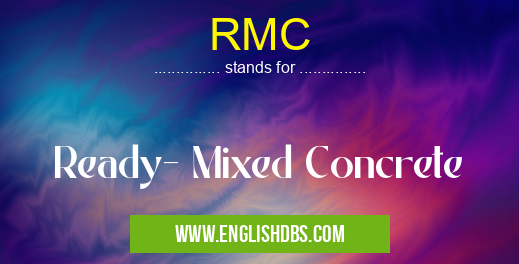What does RMC mean in ENGINEERING
RMC (Ready-Mixed Concrete) is a construction material consisting of cement, aggregate, sand, and water, pre-mixed and delivered to the construction site in a plastic state. It is used in various construction projects, including buildings, bridges, pavements, and other infrastructure.

RMC meaning in Engineering in Academic & Science
RMC mostly used in an acronym Engineering in Category Academic & Science that means Ready- Mixed Concrete
Shorthand: RMC,
Full Form: Ready- Mixed Concrete
For more information of "Ready- Mixed Concrete", see the section below.
What does RMC stand for?
The acronym RMC stands for Ready-Mixed Concrete. It refers to the process of mixing all the necessary ingredients of concrete, including cement, aggregate, sand, and water, at a central plant and delivering it to the construction site in a ready-to-use state.
Advantages of RMC
- Convenience: RMC eliminates the need for on-site mixing, saving time and labor costs.
- Consistency: Centralized mixing ensures consistent quality and properties of concrete throughout the project.
- Strength: RMC is designed to achieve specific strength requirements, ensuring the durability of structures.
- Reduced waste: Pre-mixed concrete minimizes material waste and environmental impact.
- Speed: RMC can be delivered quickly to the construction site, allowing for faster construction cycles.
Applications of RMC
RMC is widely used in various construction projects, including:
- Buildings and residential structures
- Bridges and infrastructure
- Pavements and highways
- Dams and water retaining structures
- Industrial and commercial projects
Essential Questions and Answers on Ready- Mixed Concrete in "SCIENCE»ENGINEERING"
What is Ready-Mixed Concrete (RMC)?
Ready-Mixed Concrete (RMC) is a type of concrete that is mixed in a central plant and delivered to the construction site in a ready-to-use form. It is typically used in large-scale construction projects, such as buildings, bridges, and roads.
What are the advantages of using RMC?
Using RMC offers several advantages, including:
- Consistent quality and strength
- Reduced labor costs
- Faster construction times
- Less waste
- Improved safety on construction sites
What are the different types of RMC?
There are various types of RMC available, each designed for specific applications. Some common types include:
- Normal strength concrete
- High-strength concrete
- Self-consolidating concrete
- Fiber-reinforced concrete
How is RMC delivered to the construction site?
RMC is typically delivered to the construction site in concrete mixer trucks. These trucks are equipped with a rotating drum that keeps the concrete mixed and prevents it from hardening during transportation.
What are the factors to consider when ordering RMC?
When ordering RMC, it is essential to consider factors such as:
- The required volume of concrete
- The desired concrete strength
- The slump or workability of the concrete
- The delivery schedule
- Any special requirements, such as additives or fibers
How is RMC placed and finished?
Once RMC is delivered to the construction site, it is placed and finished using various techniques, including:
- Pumping
- Pouring
- Screeding
- Vibrating
- Troweling
What is the curing process for RMC?
Curing is the process of maintaining proper moisture and temperature conditions for the concrete to gain strength and durability. RMC is typically cured for 28 days by keeping it moist using methods such as water spraying or covering it with plastic sheeting.
Final Words: RMC has revolutionized the construction industry by providing a convenient, consistent, and efficient method of concrete production. Its advantages in terms of time savings, quality control, and environmental sustainability make it an essential material in modern construction projects.
RMC also stands for: |
|
| All stands for RMC |
